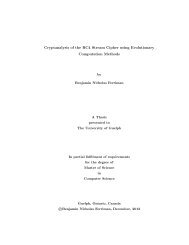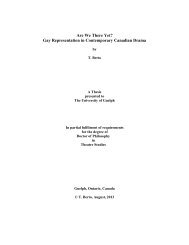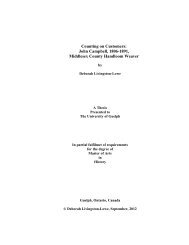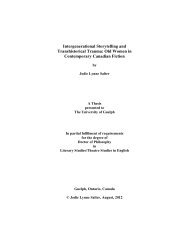THESIS - ROC CH ... - FINAL - resubmission.pdf - University of Guelph
THESIS - ROC CH ... - FINAL - resubmission.pdf - University of Guelph
THESIS - ROC CH ... - FINAL - resubmission.pdf - University of Guelph
Create successful ePaper yourself
Turn your PDF publications into a flip-book with our unique Google optimized e-Paper software.
For mechanical treatments, the obtained SF was broken down by a rotor/stator<br />
homogenizer (RSH) and high pressure homogenizer (HPH). The use <strong>of</strong> the RSH was crucial for<br />
continuous operation <strong>of</strong> the HPH whereby a homogenously suspended sample was needed for<br />
smooth processing. Chemically treating SF yielded only partially suspended fibers with many<br />
large fragments that still remained which clogged the HPH during operation. Using the RSH, the<br />
chemically treated SF was defibrillated for 5 min (PowerGen model1000, Fisher Scientific,<br />
Ottawa, ON, Canada). The resulting cellulose/water suspension was fed through the HPH for 20<br />
passes at 4000 to 6000 psi to obtain SMF (APV Gaulin Laboratory Homogenizer Model 15MR,<br />
Concord, ON, Canada).<br />
5.3.2 MORPHOLOGICAL ANALYSIS<br />
Optical microscopy micrographs <strong>of</strong> cellulose suspensions were obtained using a<br />
polarized filter lens (Model BX60 F5, Olympic Optical Co. LTD, Japan). SEM images were<br />
obtained after freeze drying <strong>of</strong> specimens. Procedure for SEM analysis was performed as<br />
described in Section 4.3.7. Transmission electron microscopy (TEM) micrographs were<br />
obtained using a Philips CM10 (Philips, Eindhoven, Netherlands) operated at 80 kV. A drop <strong>of</strong><br />
cellulose/water suspension was placed on a copper grid coated with formvar as support. A<br />
settling time <strong>of</strong> 30 sec was allowed for fibers to rest. Tissues were used to remove excess<br />
water. Staining <strong>of</strong> the fibers for contrast utilized 2% <strong>of</strong> uranyl acetate in water and applied for 10<br />
s. Excess stain was absorbed with tissues.<br />
49

















